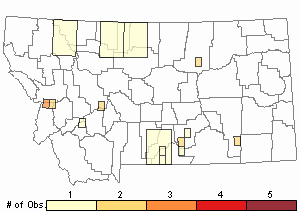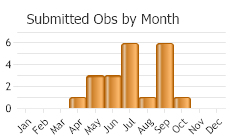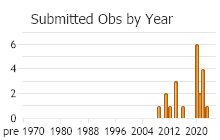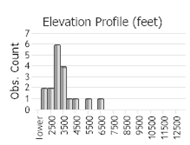View in other NatureServe Network Field Guides
NatureServe
Montana
Utah
Wyoming
Idaho
Wisconsin
British Columbia
South Carolina
Yukon
California
New York
Army Cutworm - Euxoa auxiliaris
General Description
The Army Cutworm Moth (
Euxoa auxiliaris) is a fairly large (40 - 45 mm wingspan) grey-brown moth. It is one of the largest moths in the
Euxoa genus. There are several forms of adults. The most common has a black basal dash, black between the orbicular and reniform spot, a contrasting paler grey or yellow costa and a pale streak beyond the claviform spot. A less common form has an evenly-colored pale grey or pale brown forewing. Yet another form has dark brown forewings with white outlined reniform and orbicular spots (Anweiler 2003).
The larvae is up to 40 mm long. It has a light brownish-gray head with pale brown spots. The body is pale grayish with white splotches and a brown-tinged top line. The lower portion of the body has darker, top-lateral stripes and an indistinct band of white splotches. The larvae curl up into a tight "C" when disturbed (Anweiler 2003).
Phenology
The adults may be found from spring (April and May) when they emerge, until late summer and fall (late August to early October) when they return to their breeding areas. Many of the adults which emerge in spring migrate to a higher, cooler elevation for the summer to aestivate. They return to the lowland in late summer and early fall to lay eggs which hatch after a suitable rain. As far as is known this phenomenon is most impressive along the Rock Mountain Front where the adults have their most impressive movements from the eastern plains westward to alpine habitats in the Rockies. Adults are on the wing from mid May through September, with the peak flight in July and August. Eggs are laid directly onto the soil with a preference for bare soils such as cultivated or overgrazed areas. The eggs hatch after a suitable rain, and they overwinter as partly grown larvae. They can tolerate cold temperatures, and often becomes active early in winter anytime that days climb above freezing. The larvae resume feeding in the spring, pupate, and the adults emerge in late spring to early summer. The larvae feed above ground at night and on cool days, hiding in the soil or under clods during the day. There is a single brood of long-lived adults each year. E. auxiliaris make up a large portion of the masses of moths that aestivate in rockslides in the mountains in Wyoming and Montana, and are an important seasonal food for grizzly bears. They are one of the richest foods for predators, such as grizzly bears, in this ecosystem because up to 72 per cent of the moth's body weight is fat. Thus, it is more calorie-rich than elk or deer (Powell and Opler 2009).
Diagnostic Characteristics
The Army Cutworm Moth belongs to the subgenus Chorizagrotis. This subgenus is characterized by long, apically spatulate saccular extension and short harpes. The only other member of the subgenus in the province of Alberta (and probably Montana) is Sordid Dart (E. adumbrata) which can be separated by it's longer harpes. The harpes in E. adumbrate is more than 5 times as long as wide, and in E. auxiliaries is 3 times as long as wide (Anweiler 2003).
Range Comments
The Army Cutworm Moth is commonly found in the western prairies of the United States. It is widespread in western North America, north to the Northwest Territories and south to Northern Mexico, east on occasion to Michigan, Illinois and Missouri and Texas (Anweiler 2003).
Observations in Montana Natural Heritage Program Database
Number of Observations: 29
(Click on the following maps and charts to see full sized version)
Map Help and Descriptions
Relative Density

Recency



 (Observations spanning multiple months or years are excluded from time charts)
(Observations spanning multiple months or years are excluded from time charts)
Habitat
Grasslands, croplands, meadows and other open habitats, including alpine (Anweiler 2003).
Food Habits
It has been found that larvae feed on plants in 16 families, primarily low broad-leaved herbs, but they favor cereal grasses such as
Avena,
Elymus,
Hordeum,
Poa, and
Triticum. Adults that migrate to alpine regions in late June and early July feed at night on the nectar of wildflowers. Larva are considered pests of
Avena sativa (oat) and
Triticum aestivum (common wheat) (Anweiler 2003).
Ecology
The aggregations of this species within talus slopes serve as an important food resource for grizzly bears in the Northern Divide and Yellowstone Ecosystems.
Management
For information and resources on plant pests and diseases see the USDA's Animal and Plant Health Inspection Service's
Plant Pests and Diseases ProfilesReferences
- Literature Cited AboveLegend:
 View Online Publication
View Online Publication Powell, J.A. and P.A. Opler. 2009. Moths of Western North America. University of California Press, Berkeley, CA. 369 pp.
Powell, J.A. and P.A. Opler. 2009. Moths of Western North America. University of California Press, Berkeley, CA. 369 pp.
- Additional ReferencesLegend:
 View Online Publication
View Online Publication
Do you know of a citation we're missing? White, D.D, Jr. 1996. Two Grizzly Bear studies: moth feeding ecology and male reproductive biology. Ph.D. Dissertation. Bozeman, MT: Montana State University. 79 p.
White, D.D, Jr. 1996. Two Grizzly Bear studies: moth feeding ecology and male reproductive biology. Ph.D. Dissertation. Bozeman, MT: Montana State University. 79 p.
- Web Search Engines for Articles on "Army Cutworm"
- Additional Sources of Information Related to "Insects"





